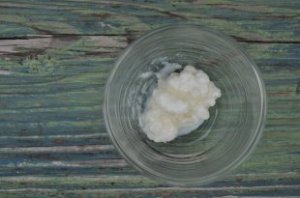
 This is the second installment in my What are Fermented Foods? series where I explain why I love kefir and what are kefir grains. I started making my own kefir from live kefir grains about 2 months ago after many false starts. I tried drinking kefir back when I started eating an unprocessed, traditionally prepared real food diet about a year ago and it didn’t sit well with me. So I took a probiotic and stuck with foods like sauerkraut and fermented condiments like mayo. I figured I wasn’t reacting well to the dairy in the kefir so recently I heard you could also make kefir from coconut milk. I was able to score some grains from a friend and also got to talk to someone about introducing kefir slowly to your body. Apparently kefir is pretty potent and while it works on healing your body, it can cause a number of symptoms for a few weeks – things like headaches, rashes and digestive issues. Once I realized this I was able to make the switch from coconut milk kefir to cow milk kefir just fine. In this post I will describe what are kefir grains, the benefits of kefir and how to start slowly with kefir and work your way up.
This is the second installment in my What are Fermented Foods? series where I explain why I love kefir and what are kefir grains. I started making my own kefir from live kefir grains about 2 months ago after many false starts. I tried drinking kefir back when I started eating an unprocessed, traditionally prepared real food diet about a year ago and it didn’t sit well with me. So I took a probiotic and stuck with foods like sauerkraut and fermented condiments like mayo. I figured I wasn’t reacting well to the dairy in the kefir so recently I heard you could also make kefir from coconut milk. I was able to score some grains from a friend and also got to talk to someone about introducing kefir slowly to your body. Apparently kefir is pretty potent and while it works on healing your body, it can cause a number of symptoms for a few weeks – things like headaches, rashes and digestive issues. Once I realized this I was able to make the switch from coconut milk kefir to cow milk kefir just fine. In this post I will describe what are kefir grains, the benefits of kefir and how to start slowly with kefir and work your way up.
What are Kefir Grains?
To understand what kefir is we must first understand the grains used to make kefir. According to by Alex Lewin, ‘Kefir grains are combinations of yeasts and bacteria living on a substrate made up of a variety of dairy components.’ These live kefir grains look a little bit like cauliflower florets and are somewhat gelatinous in texture. My favorite fact about kefir grains is that live kefir grains cannot be made or manufactured (yay! a *real* real food!). No other milk culture (yogurt, creme fraiche, etc.) forms grains so it is very unique! You can purchase kefir grains or look for someone making kefir nearby who might be able to share some. I often look to my local Weston A Price chapter for this. There is also a that shares kefir grains with people looking for them.
The exact details of their origin is not known although there are many stories ranging from the grains being the actual manna from heaven during the Israelites wandering in the desert for 40 years or a gift from Allah to the Prophet Muhammed. In any event, the grains were closely guarded secrets because of their health giving properties until the early twentieth century when a Russian spy was able to get some and then they quickly proliferated in Russia and Eastern Europe and now throughout the world.
What is Kefir and what are the benefits to drinking it?
Kefir is the drink made from the kefir grains and it has the consistency of a drinkable yogurt but is much more tart and is actually effervescent. Upon trying kefir the first time, my 3 year old daughter commented that it tasted like a milk soda! Kefir grains consume the lactose during the culturing process so lactose intolerant folks rejoice – you can apparently drink kefir. The neat thing about kefir is that it is pretty versatile – you can drink it plain or add it to a smoothie or even drain the ‘whey’ from it to make kefir cheese (like cream cheese) to use in dips like ranch dressing, etc.
Way Better Than Yogurt
Kefir made from live kefir grains has 35 different strains of beneficial bacteria and yeasts. Kefir isn’t at all like yogurt in that kefir actually colonizes our digestive tracts with this beneficial bacteria and yeast. Yogurt and many other so called probiotic foods on the market today actually only provide prebiotics or simply – they provide food for the good bacteria that live in the intestinal tract. Laboratory grown yogurt has only 1 or maybe as high as 5 strains of beneficial bacteria and laboratory grown kefir for manufactured products has only 10 strains. Commercially made kefir sold in the stores is not fermented long enough. In addition the pasteurization process after fermentation kills the probiotic microbes. So my next statement only applies if you would like to make your own – Start SLOWLY. Just a spoonful a day for the first two weeks should be enough to slowly introduce your body to this magical substance. I had some digestive issues the first two weeks (I felt like I had a brick in my stomach) and my daughter got a rash. Some people call this period ‘die off’ because it is the kefir killing off bad substances and this shows up in different ways for different people. After a few weeks of this, I could actually tell when I was ready for more because I suddenly wanted more kefir. I am now able to drink almost 2 cups a day!
Kefir boosts our immune systems by keeping healthy bacteria in our digestive tract (and remember 80% of our immune system is in our digestive track!). The fermenting bacteria produce lactic acid which heals and soothes the gut lining. Kefir is rich in vitamin A, B2, B12, D, K, calcium, magnesium, phosphorus, and typtophan. It has anti tumor properties, prevents disease, increases digestibility and it controls toxins.
How do I make kefir?
Making kefir is a pretty simple process – you do not need to maintain a constant temperature like with yogurt.
YOU MIGHT ALSO LIKE




 Saturated fat is fat that consists of triglycerides containing only saturated fatty acids. Saturated fatty acids have no double bonds between the individual carbon atoms of the fatty acid chain. That is, the chain of carbon atoms is fully "saturated" with hydrogen...
Saturated fat is fat that consists of triglycerides containing only saturated fatty acids. Saturated fatty acids have no double bonds between the individual carbon atoms of the fatty acid chain. That is, the chain of carbon atoms is fully "saturated" with hydrogen...








